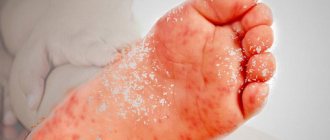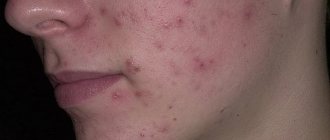In youth, the cause of acne is a hormonal storm raging in the growing body. But even an adult woman may not be all right with him. Stress, hormonal contraceptives, infections - you never know the factors that can disrupt the fragile hormonal balance.
Decorative cosmetics - powder, foundation, self-tanning - also do not contribute to skin health. Add to this snacks on the run and problems with the gastrointestinal tract - and the result is obvious. At the same time, you can get rid of this unpleasant scourge only in one case - if you find out exactly the cause that leads to the appearance of acne.
Hormonal disbalance
The content of the article
The occurrence of acne in women is most often associated with an excess of the male sex hormone testosterone. Normally, it is always present in the female body. But if its concentration increases, unpleasant changes begin.
Sweating increases, excess hair appears (hirsutism), and sebum production increases. The ducts of the sebaceous glands become clogged. Once in a favorable nutrient environment, opportunistic microflora actively multiplies. As a result, acne appears on the face.
There can be many reasons for increased testosterone levels, including those requiring treatment: polycystic ovary syndrome, tumors of the pituitary gland and adrenal glands, problems with the thyroid gland. Therefore, if you notice acne, the first thing you should do is make an appointment with a gynecologist-endocrinologist.
What to do? Consult a doctor and take a blood test for sex hormones. Important: the test must be taken in the morning on the 5-7th day of the menstrual cycle. In the future, you may need to undergo an ultrasound of the ovaries, adrenal glands, thyroid gland, and MRI of the brain.
Common reasons
The most common causes leading to acne formation are identified. They must be taken into account when prescribing tests to identify various diseases.
The following pathological factors are identified that cause blockage of pores with a concentration of purulent contents:
- endocrine disruption;
- formation of an inflammatory focus;
- digestive system dysfunction;
- diabetes mellitus and other pancreatic diseases;
- dysfunction of the thyroid gland;
- hypovitaminosis;
- unfavorable heredity;
- lack of use of epidermal care;
- weak immunity;
- spread of pathogenic microflora;
- hypersensitivity reaction;
- subcutaneous mite reproduction;
- negative psycho-emotional background;
- environmental pollution.
Often, pimples can form due to chronic infection, leading to intoxication. Therefore, it is necessary not only to identify the root cause, but also to cleanse the body of toxins, waste, and pathogenic microorganisms. To do this, you can use Enterosgel, which belongs to the group of sorbents. It effectively removes all toxic products from the gastrointestinal tract, prevents intoxication and infection. It is also applicable for allergies, removes antigens. Constipation does not occur during its use, so it can be used for a long time.
Digestive problems
This is another common cause of acne. Most often, the prerequisites for the appearance of acne are disruptions in the functioning of the small and large intestines, manifested by the development of dysbiosis. By this diagnosis, gastroenterologists mean an imbalance of intestinal microflora.
As a result, the number of beneficial bifidobacteria and lactobacilli may significantly decrease. The root cause of this may also be diseases of the upper gastrointestinal tract: chronic gastritis, cholecystitis, pancreatitis.
An imbalance immediately attracts opportunistic microbes, they show their worst properties and colonize the intestines, displacing representatives of the normal flora that do not get along with each other. Uninvited guests may include E. coli, cocci, and fungi. As a result, a large amount of toxins, their waste products, are absorbed in the intestines, and this affects the condition of the skin.
What to do? If the gynecologist-endocrinologist does not find “his” problem, he will send you to a gastroenterologist. You will need to undergo an ultrasound of the abdominal organs and a stool test for dysbiosis. If it is detected, it is necessary to normalize the diet, undergo a course of treatment with drugs containing live intestinal bacteria or stimulating the restoration of normal microflora (probiotics, prebiotics, eubiotics).
Etiology, treatment of acne on the cheeks
Rashes in the cheek area depend on the condition of the digestive tract and respiratory system. It is recommended to take into account the area where pimples occur:
- middle
- the development of an inflammatory process in the alveoli of the lungs is possible; - lower part, cheekbones
- possible development of intestinal dysbiosis, intoxication of the body; - the upper part
is the use of low-quality, low-grade cosmetics, which gradually clog pores, cause allergic reactions and the accumulation of bacteria.
If a person develops large, purulent pimples in the summer, one of the most common reasons is the use of air conditioning. Cold air can lead to a negative reaction and accumulation of sebum.
Subcutaneous mites - demodex - can spread in the cheek area. It is not visible visually, but it leads to the formation of large acne that is difficult to treat.
Therapy methods:
- checking the respiratory tract for the presence of inflammatory pathology, comprehensive treatment of the disease;
- the use of probiotics and sorbents to eliminate intoxication of the digestive tract;
- the use of external agents to eliminate inflammation and bacterial infection of the skin.
If skin defects develop, it is recommended to avoid cosmetics that contain harmful substances. For example, paraffin, mineral oil, lanolin. The components clog pores and cause the formation of comedones.
Chronic tonsillitis
In almost a quarter of cases, the cause of acne may be chronic inflammation of the tonsils. The situation with an unhealthy throat is reminiscent of a problematic intestine - local dysbiosis also develops there, and pathogenic staphylococci, streptococci and other bacteria actively multiply. Bacterial toxins enter the blood, and the skin suffers again.
Another mechanism is a disruption of the lymphatic system (after all, the tonsils are a lymphoid organ), which is closely connected with the sebaceous glands. Violation of the outflow of lymph causes its stagnation, but through these same vessels microorganisms from the tonsils enter the sebaceous glands. Inflammation develops and acne appears on the face.
What to do? Undergo a course of treatment for chronic tonsillitis. Various options are possible - a course of antibacterial therapy, physiotherapeutic techniques, laser. Surprisingly, after sanitizing the source of infection in the throat, acne often disappears forever.
Pimple distribution map
Typically, pimples are localized on the following areas of the face and surrounding tissues:
- forehead, nose, chin;
- cheeks, temples;
- lips, eyelids.
A cosmetologist, dermatologist, therapist, and gastroenterologist are involved in recognizing the development of the disease depending on the spread of acne.
If acne is located in the eyelid area, liver and kidney pathologies can occur in the human body. If there are pimples on the chin, problems are sought in diseases of the digestive tract.
There are various zones on the face where epidermal pathology can spread. This is a kind of mirror reflecting the state of internal organs and systems.
In order for a doctor to accurately understand the possibility of developing the disease depending on the spread of acne, it is necessary to know which organs or systems are associated with different areas of the face. These data are shown in the table.
| Face area | Internal organs |
| Cheeks | Respiratory tract |
| Cheekbones, chin | Digestive system |
| Nose | The cardiovascular system |
| Wings of the nose | Epigastric region |
| bridge of the nose | Pancreas |
| Eyelids | Reproductive and urinary system |
| Mouth and surrounding area | Intestines |
| Forehead | Gastrointestinal tract |
| Brow ridges | Circulatory system, gastrointestinal tract |
The presence of pimples in this area alone is not enough to determine the diagnosis. Based on the symptoms, the doctor assumes a pathology, prescribing laboratory and instrumental tests. It is with their help that various types of diseases are identified.
Contact dermatitis
The modern woman's makeup bag is cramped. And daily application of even the safest, but still chemical compounds to the skin of the face is not in vain. It is no coincidence that almost all stars sooner or later face the problem of acne. The more makeup, the higher the risk.
What to do? If you notice a connection between the use of cosmetics and the appearance of acne or the cause of the rash cannot be determined, your path lies with a dermatocosmetologist. The doctor will help you identify provocateurs, select a suitable line of cosmetics and care products for you, and prescribe medications that soothe your skin.
Diagnosis and treatment of acne on the nose
Rashes and acne development most often occur on the nose. This is a problem area with abundant sebum secretion. Therefore, it is necessary to use high-quality treatment to not only eliminate acne, but also prevent its recurrence. Some of the most common causes of acne on the nose are:
- excessive secretion of sebum with clogged pores;
- metabolic disease;
- hormonal imbalance;
- careless, poor quality care;
- dysfunction of the pancreas, islets of Langerhans;
- inflammatory diseases of the stomach, for example gastritis;
- cardiovascular pathologies;
- chronic bronchitis, bronchial asthma.
Treatment methods:
- consumption of high-quality food, adequate physical activity;
- use of high-quality cosmetics for facial care;
- adequate hormonal therapy in the presence of endocrine pathology;
- use of antiseptic, anti-inflammatory agents for external use.
There are special strips to remove clogged pores on the nose. It is recommended to use them over a long period of time to cleanse the pores.
Detecting and treating acne around the eyes
Factors leading to the formation of pimples around the eyes:
- pathologies of the kidneys, adrenal glands;
- insufficient intake of water into the body;
- the presence of an allergic reaction, for example, when applying low-quality cosmetics.
Treatment methods:
- stabilization of water and electrolyte balance by drinking large amounts of water, at least 2 liters per day;
- compliance with sleep and wakefulness, long rest.
If acne is concentrated around the eyes, it is prohibited to use aggressive cosmetic preparations intended for antiseptic treatment.
This can cause the formation of wrinkles and irritation. Only soft, gentle cosmetic products are used.
Features of treatment, identifying the causes of acne around the lips
Rashes around the lips are very rare. This usually indicates the following abnormalities in the body:
- impaired fecal formation, accompanied by constipation or diarrhea;
- increased flatulence, bloating;
- colic associated with intestinal spasms;
- stress, depression, nervous tension;
- hormonal imbalance;
- unsuccessful hair removal around the lips, leading to clogged pores and inflammation;
- allergic reaction.
Therapy methods:
- prohibition of consuming large amounts of carbohydrates;
- use of hormones to stabilize endocrine levels;
- the use of probiotics that stabilize the state of intestinal microflora.
If rashes appear on the face in a certain area for a long time, the cause of the lesion can be assumed. But you are additionally required to pass laboratory and instrumental tests prescribed by your doctor. It is impossible to make a diagnosis on your own by starting therapy. Such treatment will be incorrect and will lead to many negative consequences.










